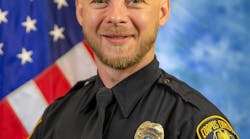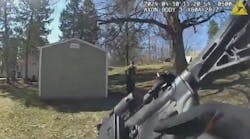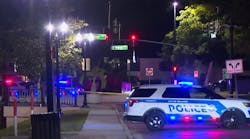I've recently been looking over a number of law enforcement firearms training plans, including both qualifications and scenario-based courses of fire. One of the things that jumps out at me is the minimal amount of one handed shooting that is either required or encouraged. In fact, the only one handed shooting required on the qualification courses is usually at very close ranges, three yards or less, and requires point shooting from the hip. The implication seems to be that the folks who design these programs only expect one handed shooting to be a close-quarters, quick-draw sort of encounter. Okay, that is certainly one possibility, but hardly the only one, and probably not the most likely. Now, I'm the first person to say that you should do your shooting with both hands, if at all possible. That provides more stability and accuracy over one-hand shooting and should yield the best results. But, it is not a perfect world and, as Clint Smith often says, the fight will be what it is. Once the one-handed shooting begins, it's a bit late to learn that you should have been practicing.
You may find yourself having to shoot with one hand for a number of reasons. You may be carrying something that can't be dropped, say, a flashlight. Or you may be trying to rescue someone, like a wounded partner. Or you may be using the other hand to open doors or maneuver through or around obstacles. Or, maybe you've been injured or wounded. Whatever the cause, it does happen and it happens often enough that to avoid training in one-handed shooting and gun manipulation is a serious mistake.
A classic example of the sudden need for injury-induced, one-handed shooting can be found on a horrible April day in Miami in 1986. When the now-infamous FBI Miami shootout began, Special Agent Edmundo Mireles was one of eight agents who found themselves in that life-and-death struggle with two professional criminals, Michael Platt and William Matix. As Mireles was maneuvering to deploy his Remington 870 pump action shotgun, he was hit in the left forearm by a .223 bullet fired by Platt. Mireles later described his suddenly useless left arm as looking like it was "turned inside out." From that point on, with the gun battle raging around him, Ed Mireles managed to fire all of the rounds from his shotgun at Platt and Matix, achieving several non-fatal hits. In spite of the fact that he had never received any training in operating the shotgun one-handed, Mireles, now seated on the pavement with his back against a car bumper, improvised. He braced the butt of the gun against the ground between his knees to work the action, and then balanced it on the bumper of the car to fire. Finally, as Platt and Matix attempted to flee in one of the FBI sedans, Ed Mireles was able to put an end to the gunfight by advancing on the car, firing his revolver one-handed as he moved, finally killing Platt and Matix. Agent Mireles, by the way, wasn't the only one with a wounded arm. Agents Gordon McNeill and John Hanlon also received disabling wounds to their gun hands. In his excellent "Ayoob Files" recounting of the incident, Massad Ayoob makes this important point regarding the predicament of McNeill and Hanlon: "Both stated afterward that when their guns were empty and they couldn't reload due to wounds of the gun hands, 'The air and the adrenaline ran out of them.' To survive, you have to fight, and to fight you need wherewithal."
Which brings me to my next point. You not only need to practice shooting with your "strong" hand, but you also need to practice loading and reloading your gun using one hand. And then, you need to do the same with your other hand. Call it your "weak" hand, or if you want to be PC, your "non-dominant" hand. Either way, it isn't used to performing such tasks and therefore needs the practice. Can you draw your gun with your weak hand only? Or reload the gun using just that hand? It can be done, with just a little training on the techniques and some practice. If you can't draw your gun from your high-tech, retention Level III duty holster with your non-dominant hand, then I'd say you should be thinking very seriously about carrying a backup gun, accessible from your off side.
I think some people avoid doing one-handed shooting simply because they don't think they'll be any good at it. And we all hate to do things that don't make us look good. But, training is about developing skills that need the work, not just showing off what we do well. The fact is, one-handed shooting isn't as tough as some people seem to think, if it is done correctly. The fundamentals of a strong stance, firm grip and good trigger control are not just a good idea; they are essential with only one hand controlling the gun. With a little practice, you can be shooting accurately at distances that far exceed the usual three yards on qualification courses. And be shooting well while moving. And making a smooth transition to shooting well with your weak hand. Try it. Amaze yourself and your friends. Befuddle and intimidate your enemies. In other words, look good. Whatever your motivation, do it. It's your life.
Just how important is it to practice with your non-dominant hand? A few years ago there was a raging debate on one of the internet gun forums. It was about the importance of one-handed shooting in general. Several folks were quite adamant that practicing one handed was just a waste of time, as there rarely is a need for it. As if in answer to such ignorance, a couple of weeks later there was a police shooting in a small community near where I used to live. The lone officer on duty in the town was dispatched to a domestic disturbance at a residence. Since he was alone, his backup was coming from an adjacent jurisdiction. When the officer arrived at the front door, he was standing on an "L" shaped porch that ran on two sides of the house. As he was knocking on the front door, the suspect (they call them "actors" in that state), who had left the house by a side door onto the same porch, suddenly came around the corner of the house, gun in hand. He fired just as the officer was drawing his pistol. The shot hit the officer in his gun hand, causing him to drop the gun onto the porch. At the same moment, before he could fire again, the shooter's attention was diverted by the arriving backup officer. In that instant, the first officer was able to reach down, retrieve his gun with his "weak" hand, and forthwith dispatch said "actor" to his next life. It happens! It is sheer folly to imagine that it will not, or that it does not. I can't remember who said this, and I may be paraphrasing very poorly, but it does fit the situation: "Reality has a way of making a fool out of denial." Don't just train for the best of circumstances. Train for the worst. And please, stay safe out there.


